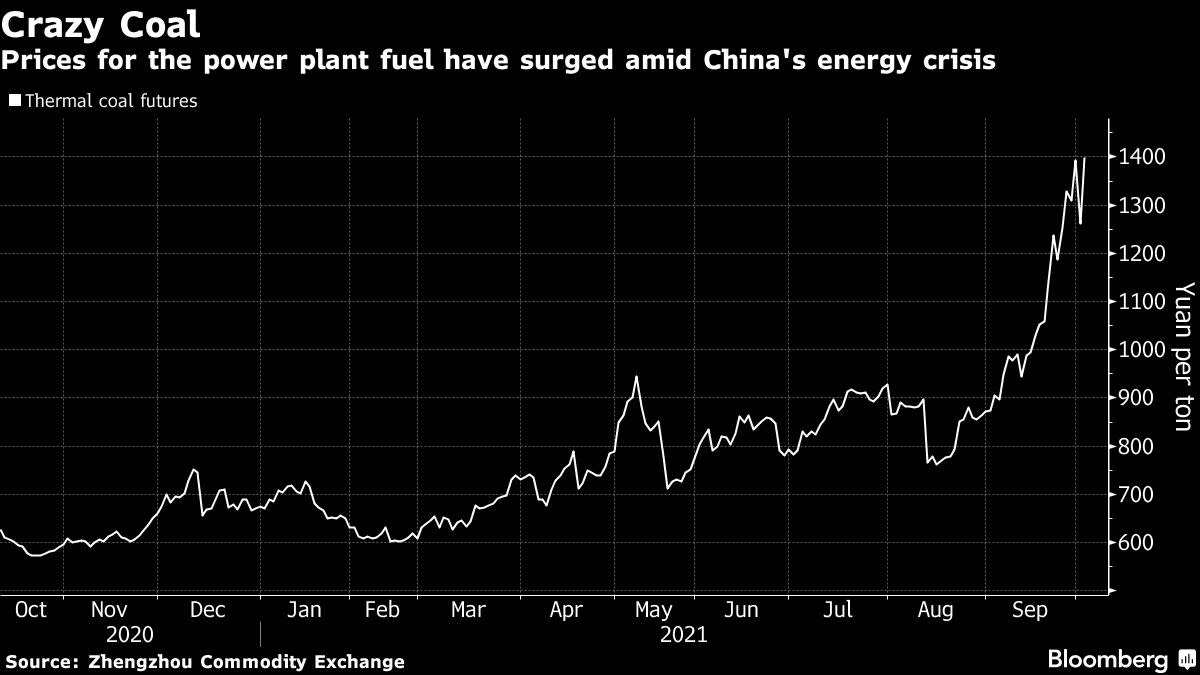China Coal Futures Surge to Record as Flood Swamps Mine Hub

(Bloomberg) — Heavy rains and flooding expanded mine shutdowns in China’s biggest coal-producing region, sending prices to a record and hindering efforts by Beijing to boost energy supplies for winter.
Most Read from Bloomberg
Floods have closed 60 of the 682 coal mines in Shanxi province, a region that has produced 30% of China’s supply of the fuel this year, adding to a worsening energy crisis that threatens the country’s economic growth.
The mine outages are complicating China’s efforts to boost coal output and ensure power supplies for the winter heating season. The powerful State Council on Friday said it will allow higher electricity prices in a bid to boost generation amid the rising costs.
The council also said it would gradually allow all coal-fired power to be traded in the market instead of being subject to regulated prices, and promoted increasing capacity in qualified coal mines. China’s government has asked miners to spare no costs in boosting coal supplies, and has given them permission to operate at full capacity even after hitting their annual quotas.
Even with the efforts, China could face a coal supply gap of 30 million to 40 million tons in the fourth quarter, Citic Securities analysts said in an Oct. 8 report. A shortage of the fuel could cut industrial power use by 10% to 15% in November and December, which would potentially translate into a 30% slowdown in activity in the most energy-intensive sectors like steel, chemicals and cement-making, according to UBS Group AG.
Read more: China to Allow Power Prices to Rise Amid Energy Squeeze
The State Council said electricity prices will be allowed to rise by as much as 20% against a benchmark, compared with a current cap of 10%. Analysts led by Sun Binbin at Tianfeng Securities Co. estimate that such an increase will lead to a 0.91% increase in overall inflation, translating to less than a 0.5% rise in the consumer price index and about a 1% rise in the producer price index, due to the impact from energy intensive industries.
Coal futures on the Zhengzhou Commodity Exchange rose 12% Monday to close at 1,408.2 yuan ($218.76) a ton, a new record for the most-active contract.
Spot prices are even higher, with 5,500 kilocalorie coal in Qinhuangdao at about 1,900 yuan a ton now, China Coal Resource analyst Feng Dongbin told Citigroup analysts, according to a note dated Monday. Prices will probably peak at 2,000 yuan before falling back to 1,000 in the first quarter of 2022, he was quoted as saying.
The power grid may face some relief in the near term, as hot weather in cities including Shanghai and Nanjing is supposed to cool off, with temperatures dropping from about 30 degrees Celsius to 20, according to the China Public Meteorological Service Center.
Still, the cool wave could be an omen for lower temperatures boosting heating demand during the winter. The China Meteorological Administration is predicting a La Nina weather pattern between October and December, which may bring more frequent and stronger cold waves.
Meanwhile the heavy rain in Shanxi continues, where at least five people have died, according to the South China Morning Post. More than 120,000 people have been evacuated, Xinhua reported Sunday, with 190,000 hectares of crops damaged and 17,000 houses collapsed.
(Updates prices in seventh paragraph and analyst comment in eighth paragraph.)
Most Read from Bloomberg Businessweek
©2021 Bloomberg L.P.




